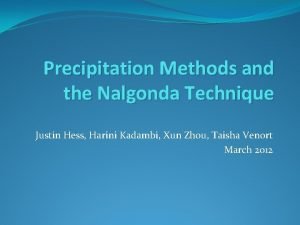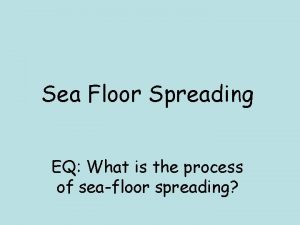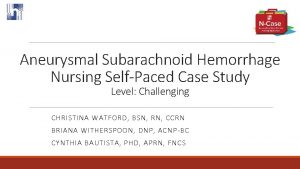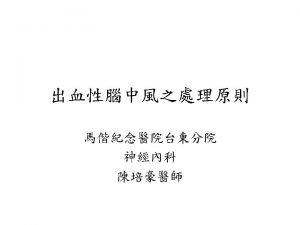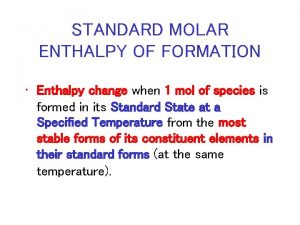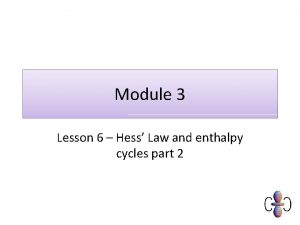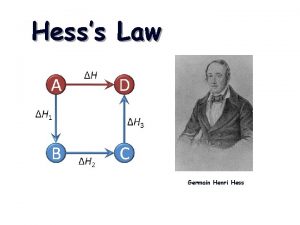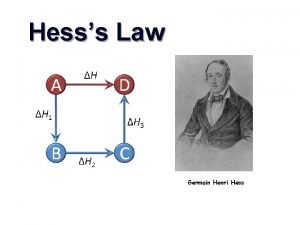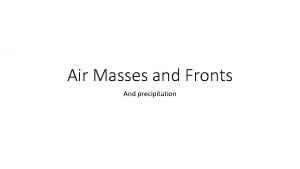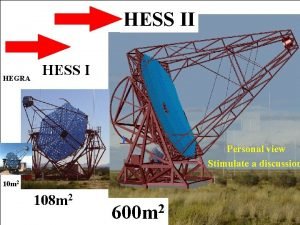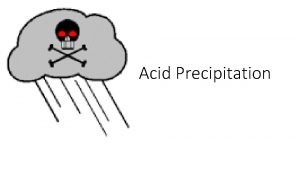Precipitation Methods and the Nalgonda Technique Justin Hess





















- Slides: 21

Precipitation Methods and the Nalgonda Technique Justin Hess, Harini Kadambi, Xun Zhou, Taisha Venort March 2012

Problem Statement �Remove Fluoride from Groundwater in Odisha �Human Health: detrimental when exposure is excessive for long-term; accumulation in bones causes skeletal fluorosis �Plant health: Fluoride can be easily taken up by plants through water uptake, has been shown to slow plant growth

Defluoridation Techniques �Precipitation using Alum �Activated Alumina �Bone Charcoal (Calcium Phosphate Exchange) �Nalgonda Technique

Precipitation Background �Addition of chemicals (precipitants) to induce formation of floc. �Precipitants performance based on rapid ability to disperse/ separate fluoride in water. �Most common method : adding calcium salts to water leading to the precipitation of ca. F 2. �Fluoride concentration can be still be relatively high due to rest and flocculation. �Further treatment is usually done (activated alumn adsorption / ion exchange) for more effective removal.

Precipitation Using Alum �Efficient method of flocculation (~77% removal rate) �Alum: Aluminum Sulfate Al 2(SO 4)3 �Used extensively in water treatment in industry �Alum dissolution: �Al 2 (SO 4)3 + 18 H 2 O = 2 Al 3+ + 3 SO 42– + 18 H 2 O �Aluminium precipitation (Acidic): � 2 Al 3+ + 6 H 2 O = 2 Al(OH)3 + 6 H+

Advantages/Disadvantages Advantages Disadvantages �High Pollutant Removal Ability �Can be used on community level � Optimization of treatment can be difficult � p. H of water is imperative (must be between p. H 7. 0 -7. 2) to work effectively � High Maintenance � Frequent maintenance required � Generally not cost effective for small sites � Remove floc build-up from settling pond

Activated Alumina �Dehydration of Aluminum Hydroxide to produce Aluminum Oxide �Used widely in industry for many applications including arsenic, fluoride and sulfur removal from gas streams

Advantages/Disadvantages Advantages �Very effective (80 -90% removal of Fluoride) �High mechanical strength and thermal stability Disadvantages �Effectiveness dependent upon p. H �Many factors which may inhibit removal � (hardness, high level of silica or boron) �Maintenance is required and is expensive

Bone Charcoal �Calcium Phosphate Exchange �Ion Exchange Ca. Co 3 replaced by fluoride to form insoluble fluorapatite �Bones are heated to high temperatures �Quality controlled by amount of oxygen present in atmosphere while charring �Bone char has low Ksp (1. 3 E-32) at 25°C �Inexpensive and largest resorvoir of carbon �Filtration is easy because it does not clump when exposed to water �Removal capacity 1000 mg/L

Bone Char Removal

Disadvantage �Culturally Acceptable? �Religious beliefs may constrain use of animal bones

The Nalgonda Technique �Consists of several steps to treat water �Alum is added to water to start flocculation � Al 2 (SO 4)3 + 18 H 2 O = 2 Al 3+ + 3 SO 42– + 18 H 2 O � 2 Al 3+ + 6 H 2 O = 2 Al(OH)3 + 6 H+ � F- + Al(OH)3 = Al-F complex + undefined product �Lime is added to neutralize p. H � 6 Ca(OH)2 + 12 H+ = 6 Ca 2+ + 12 H 2 O �Sedimentation �Filtration �Disinfection

When should the Nalgonda process be used? �“Absence of acceptable, alternate low fluoride source within transportable distance. ” �“Total dissolved solids below 1500 mg/l; desalination may be necessary when the total dissolved solids exceed 1500 mg/l. ” �“Total hardness is below 600 mg/l. ” �“Hardness >200 mg/l and <600 mg/l require precipitation softening, and > 600 mg/l becomes a cause for rejection or adoption of desalination. ” �“Alkalinity of the water to be treated must be sufficient to ensure complete hydrolysis of alum added to it and to retain a minimum residual alkalinity of 1 to 2 meq/l in the treated water to achieve p. H between 6. 5 to 8. 5. in treated water. ” �“Raw water fluorides ranging from 1. 5 to 20 mg. F/l. ” (Water Resources Research Foundation)

Why choose the Nalgonda Technique? (continued) (taken from Feenstra, et al. , 2007, p. ii)

Approximated does of alum (mg/L) to obtain levels of Fluoride at less than 1 mg/L (taken from Water Resources Research Foundation)

Varying the Nalgonda Technique Fluoride levels before and after treating tap water and drinking water with different concentrations of alum and lime (taken from Suneetha et al. , 2008)

Mechanism of Nalgonda Technique �Material Needed: lime and aluminum salts �Process: § rapid mixing § flocculation § sedimentation § filtration § disinfection and distribution �Used in large residential scale

Mechanism of Nalgonda Technique

Advantages of the Nalgonda Technique �It is adoptable by local people and they can be easily taught to use it �Energy cost is low �Has been implemented in India �Low cost: annual cost at 0. 04 cubic meters per capita per day works out to be Rs. 15/ for domestic treatment & Rs. 30/- for community treatment based on 5000 population for water with 5 mg / l F and 400 mg/l alkalinity with requires 600 mg / l of alum (Central Pollution Control Board, p. 48)

Disadvantages of the Nalgonda Technique �Alum will increase the sulfate concentration of water. In case of improper treatment, it is possible that the concentration of aluminum ion will exceed 0. 2 mg/l in the treated water. This may raise the possibility of other diseases. (Central Pollution Control Board, p. 49) �Sludge as a byproduct – what to do with it? �Treatment efficiency is limited to about 70% -- is this enough? �Skills necessary to operate the Nalgonda process, as well as a long time commitment

References Brunt, R. , Vasak, L. , & Griffioen, J. (2004). Fluoride in Groundwater: Probability of occurence of excessive concentration on global scale. Utrecht. Central Pollution Control Board. Status of Water Treatment Plants in India. Fawell, J. , Bailey, K. , Chilton, J. , Dahi, E. , Fewtrell, L. , & Magara, Y. (2006). Fluoride in Drinking-water Feenstra, L. , Vasak, L. , & Griffioen, J. (2007). Fluoride in groundwater: Overview and evaluation of removal methods. Utrecht. Reardon, E. J. , & Wang, Y. (2000). A Limestone Reactor for Fluoride Removal from Wastewaters. ENVIRONMENTAL SCIENCE AND TECHNOLOGY, 34, 3247 -3253. Retail Market Price Trends (Industrial Chemicals). from www. indianchemicals. com/chemiprices. htm Suneetha, N. , Rupa, K. P. , Sabitha, V. , Kumar, K. K. , Mohanty, S. , Kanagasabapathy, A. S. , et al. (2008). Defluoridation of water by a one-step modification of the Nalgonda technique. Ann Trop Med Public Health, 1(2), 56 -58. Water Resources Research Foundation. Chapter 6. from http: //www. globenet. org/preceup/pages/ang/chapitre/capitali/cas/indme_g. htm
 Nalgonda technique steps
Nalgonda technique steps Gravimetry steps
Gravimetry steps Co precipitation and post precipitation
Co precipitation and post precipitation Wax pattern fabrication pdf
Wax pattern fabrication pdf Harry hess and seafloor spreading
Harry hess and seafloor spreading Harry hess and seafloor spreading
Harry hess and seafloor spreading Continental drift michael sammartano
Continental drift michael sammartano Hunt and hess subarachnoid hemorrhage
Hunt and hess subarachnoid hemorrhage Thermodynamics enthalpy of reaction and hess's law
Thermodynamics enthalpy of reaction and hess's law Hunt and hess grading
Hunt and hess grading Enthalpy and calorimetry
Enthalpy and calorimetry What is this
What is this Define standard enthalpy of formation,δhf⁰
Define standard enthalpy of formation,δhf⁰ Ib chemistry topic 5
Ib chemistry topic 5 Standard molar enthalpy change of formation
Standard molar enthalpy change of formation Enthalpy of formation hess law
Enthalpy of formation hess law Puffing billy aspirateur
Puffing billy aspirateur Hess law
Hess law Hess law
Hess law Hess cycle formation
Hess cycle formation Susan hess golftini
Susan hess golftini Does enthalpy change with moles
Does enthalpy change with moles
